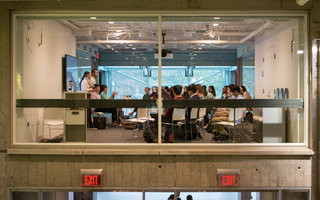{shortcode-0dbac193c11eb90f4957123b686728e47b7549cb}
Harvard’s “community compact” for students on campus will expand this spring to include a color-coded system that represents different phases of campus reopening amid the coronavirus pandemic, according to a Dec. 4 update from the Dean of Students Office.
The strictest guidelines — at “Level 0: Purple” — take effect once undergraduates arrive on campus and undergo a quarantine period during which students must remain in their rooms for 24 hours. Students may then only leave their rooms to pick up meals, drop off tests, or go on brief walks until a third negative result — usually eight or nine days later.
After purple, each subsequent color — red, orange, yellow, lime, and green — represents the gradual opening of more on-campus spaces and the possibility for College-sponsored indoor or outdoor events.
At the sixth and highest level — “Level 5: Green” — undergraduates can expect all residential common spaces, dining halls, and house gyms to be open with limited capacity. In addition, this level allows the houses to hold small gatherings in residential common spaces and suites.
The guide to the color system also states that, beyond the initial quarantine period, no specific period of time is planned for any particular stage.
“Other than the purple/arrival quarantine level, there is no distinct timing attached to each,” it reads. “The ability to move between levels is directly tied to student behavior and public health conditions.”
The document states that moving between levels will occur based on conditions “including but not limited to” student compliance with the guidelines, local transmission rates, and government public health regulations.
The document does not describe which specific public health conditions correspond with each reopening level. It also does not mention which University officials are responsible for determining the College’s level or how frequently its “color” will be reviewed and updated.
The DSO’s update comes days after Dean of the Faculty of Arts and Sciences Claudine Gay announced the University’s decision to welcome back roughly 3,100 undergraduates and give seniors and currently enrolled juniors priority to available space. Later in the week, administrators including Dean of the College Rakesh Khurana and Dean of Students Katherine G. O’Dair elaborated on spring residential plans, reiterating the fact that campus would be a different experience from last year.
In a November interview with The Crimson, O’Dair said many students criticized a lack of communication about a timeline for opening campus spaces. In the interview, she added that this feedback factored into spring planning.
“Students have said it would be nice if you would have told us what was next or what was coming,” she said. “We were kind of learning this along with everyone else, trying to figure it out. I think we again are going to apply whatever that learning is to any future on-campus population.”
—Staff writer Sydnie M. Cobb can be reached at sydnie.cobb@thecrimson.com. Follow her on Twitter @cobbsydnie.
—Staff writer Declan J. Knieriem can be reached at declan.knieriem@thecrimson.com. Follow him on Twitter at @DeclanKnieriem.
Read more in News
Guido Goldman, Co-Founder of Center for European Studies, Dies at 83















